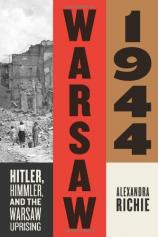Warsaw 1944: Hitler, Himmler, and the Warsaw Uprising
Review
Warsaw 1944: Hitler, Himmler, and the Warsaw Uprising
“In one evening Himmler and Hitler had decided that the entire population remaining in one of Europe’s great capitals was to be murdered in cold blood.” Paying homage to the Poles who resisted, fought and died in the destruction of Warsaw, Alexandra Richie now lives there and has created an enduring testament.
Warsaw was a gem of European cities, having enjoyed a true renaissance that began in 1918 but ended with bombs being dropped upon it in 1939, leaving 25,000 people dead. That was a faint prelude. Hitler’s plan for Warsaw began with the subjugation of the Jews, despite their strong-willed resistance. But later, seeing that the Poles were obdurate, he realized he must destroy the Polish spirit by subduing Warsaw. When an articulated resistance arose, in the form of an army known as the AK (Armania Krajowa), Hitler and Himmler determined that the city must be razed. The cruelty of the methods used as described here will be almost unbelievable to a modern reader.
"Paying homage to the Poles who resisted, fought and died in the destruction of Warsaw, Alexandra Richie now lives there and has created an enduring testament."
One simple expedient involved simply herding people of all ages out onto the street and shooting them en masse, the corpses then burned where they lay. Believing Poles to be untermenschen, the German soldiers committed rape and slaughter in the most savage manner possible. Small tanks, precursors of modern stealth weapons, were loaded with explosives and operated by remote control to explode on impact with barriers built by citizens to protect their neighborhoods. Poles were made to march ahead of the German army as a human shield in case of attack. Looting was rife. Thousands were sent away to work and die in concentration camps. In Warsaw in one day, 40,000 people were killed, the largest casualty numbers of the entire war for a ground action. One survivor described the horrors witnessed as “scenes as if from the Bible.”
In 1944, near the end of the long war, the tide was turning against the Germans as the Soviet army headed west after quelling the Nazi incursion into Russia. The Poles took this as a hopeful sign, believing that the Soviets would soon liberate their city, so their small but tactically brilliant home army began to pick away at the German occupiers. Tragically, the AK’s calculations were wrong. Stalin had his own ideas about future subjugation of the Poles, and Hitler maniacally ordered the absolute obliteration of the city.
Drawing from memories of a handful of Polish survivors and those of other nationalities who were in or near Warsaw during that fateful year, Richie, who has previously authored FAUST’S METROPOLIS, about the city of Berlin, paints a picture of bravery in the face of hopelessness and slaughter. Again and again, the Poles of Warsaw tried to regenerate their homes; in clearing away rubble, they found tons of ash where bodies had been incinerated and mounds of corpses. The sewers of the city were unusable because they were filled with Jewish bodies.
Warsawians were soon forced to trade the terrors of war for the oppression of the Soviet Union. As Richie states, “after the war, evasion, lies and amnesia dominated the collective German, Soviet, British and American memories of the Warsaw Uprising.” Though the city was partially rebuilt, little tribute was paid to the courage of its citizens in wartime. However, as Richie makes clear, there are a few people who do not have “amnesia” and still remember the before and after scenes of Warsaw, a place once lit with enthusiasm, art and intellectual idealism that became, in the crossfire of war, “the city of eternal night.”
Reviewed by Barbara Bamberger Scott on December 20, 2013
Warsaw 1944: Hitler, Himmler, and the Warsaw Uprising
- Publication Date: December 10, 2013
- Genres: History, Nonfiction
- Hardcover: 752 pages
- Publisher: Farrar, Straus and Giroux
- ISBN-10: 0374286558
- ISBN-13: 9780374286552



